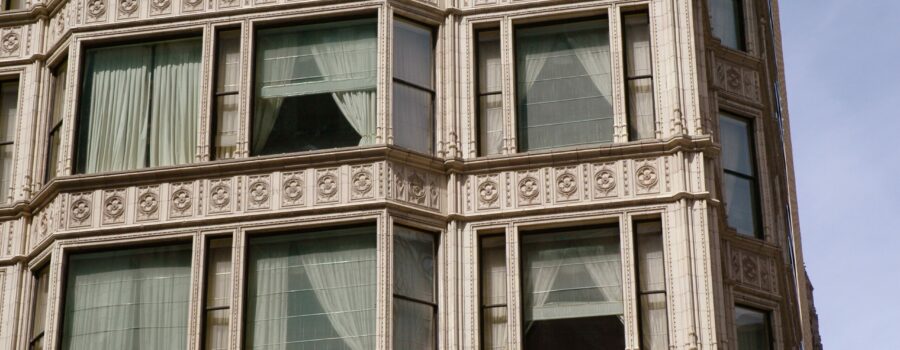One Sentence
The Reliance Building was designed with glazed white terra cotta cladding, which was believed to be self-cleaning; this proved to be untrue, but the pale facade became a staple of the building and a symbol of proto-Modernist architecture.
One Paragraph
When Charles Atwood decided to use terra cotta as cladding for the Reliance Building, it was met with a variety of opinions. Terra cotta was cheaper and easier to work with, but many questioned its legitimacy within an architectural setting. Some found it unnecessary, such as Chicago architect William Le Baron Jenney, who wrote in the Inland Architect and News Record, “There must be sufficient material and no more”.[1] Others found it too plain, including critic Montgomery Schuyler, who claimed, “The employment of [terra cotta cladding] throughout seems almost like the frank abandonment of architecture”.[2] These divisive perspectives can be attributed to the fact that the Reliance Building was designed in the late nineteenth century, so a transition into Modernism was underway but far from complete. Although not everyone embraced it, terra cotta was being used in a new way—one which predicted the future of American architecture.
One Page
Glazed terra cotta came onto the American architectural scene in the late nineteenth century and although it gave way to concrete by the 1930s, it saw prominent use during its time. The best example of this is the Reliance Building, which was designed in part by James Atwood while he worked at D. H. Burnham and Co. It was Atwood’s decision to incorporate glazed white terra cotta cladding in the facade and that decision has been studied ever since the building’s completion in 1895. This use of terra cotta contributed to the Reliance Building’s status as a frontrunner in Modern architecture.
There were many reasons why glazed terra cotta was chosen for the Reliance Building, but one of the most advertised ones was that it was self-cleaning; since the glaze was so smooth, any dirt would be washed off by the rain. The concept of a pristine white building shining through the smoky, big city atmosphere was quite appealing, and Charles Jenkins wrote about it in an article for Architectural Record: “As a material for exterior construction it will be largely used in such cities as are afflicted with a smoky, sooty atmosphere”.[3] Although the self-cleaning claim was proven false, Atwood used this same cladding method in some of his other buildings, including his designs for the World’s Columbian Exhibition in 1893. These pale facades earned Chicago the nickname of the “White City” and caused a temporary resurgence of interest in Classical architecture.[4]
The Reliance Building’s obviously nonstructural use of terra cotta over the steel frame construction has led historians to describe it as “prophetic of the development of American modernism”.[5] The Reliance Building was named for its functionality which, in combination with the overall minimalist approach to the building, became a major factor in modernist architecture. The terra cotta and plate glaze made up one of the earliest curtain walls, and this facade style became one of Le Corbusier’s key principles a few decades later.[6] This building is a key transition piece from the historicism of the past to the exciting new technologies of the future.
The use of glazed terra cotta in American architecture may have been short-lived, but its impact cannot be ignored. It predicted several modernist trends while maintaining historic values and without the unique facade that covers two of its walls, the Reliance Building would not have the legacy that it does.
[1] William Le Baron Jenney, The Chicago Construction, or Tall Buildings on a Compressible Soil (Chicago: Inland Pub Co., 1891), 41.
[2] Montgomery Schuyler, D. H. Burnham and Co. in Great American Architects Series (New York: Architectural Record Company, 1896), 59.
[3] Charles Jenkins, A White Enameled Building (New York: Architectural Record Company, 1895): 299.
[4] Helene Valance, Dark City, White City: Chicago’s World Columbian Exposition, 1893 (Paris: Caliban, 2009).
[5] Joanna Merwood, The Mechanization of Cladding: The Reliance Building and Narratives of Modern Architecture (Cambridge: The MIT Press, 2001), 53.
[6] Le Corbusier, Towards a New Architecture, Trans. Frederick Etchells (New York: Dover Publications Inc., 1986).





